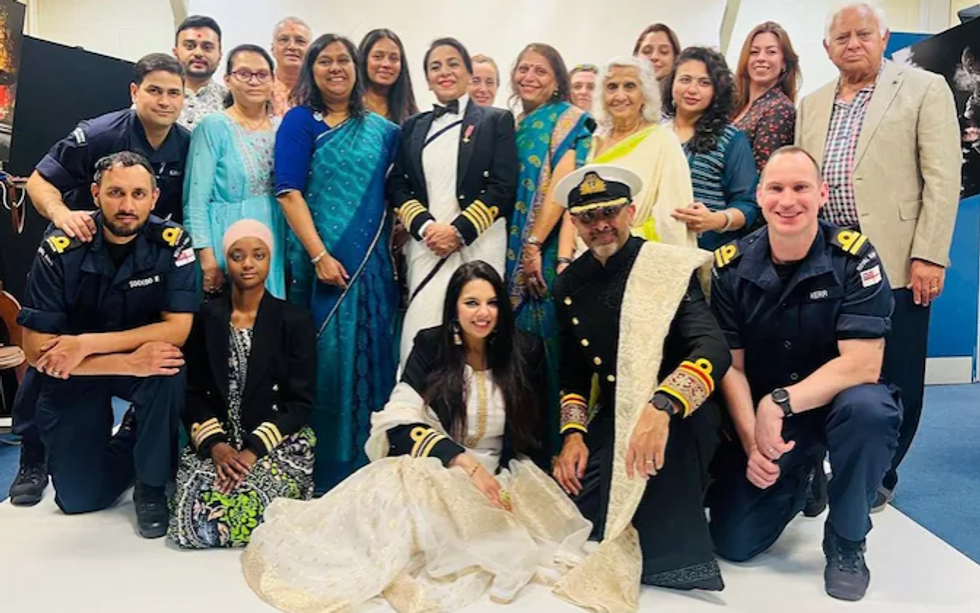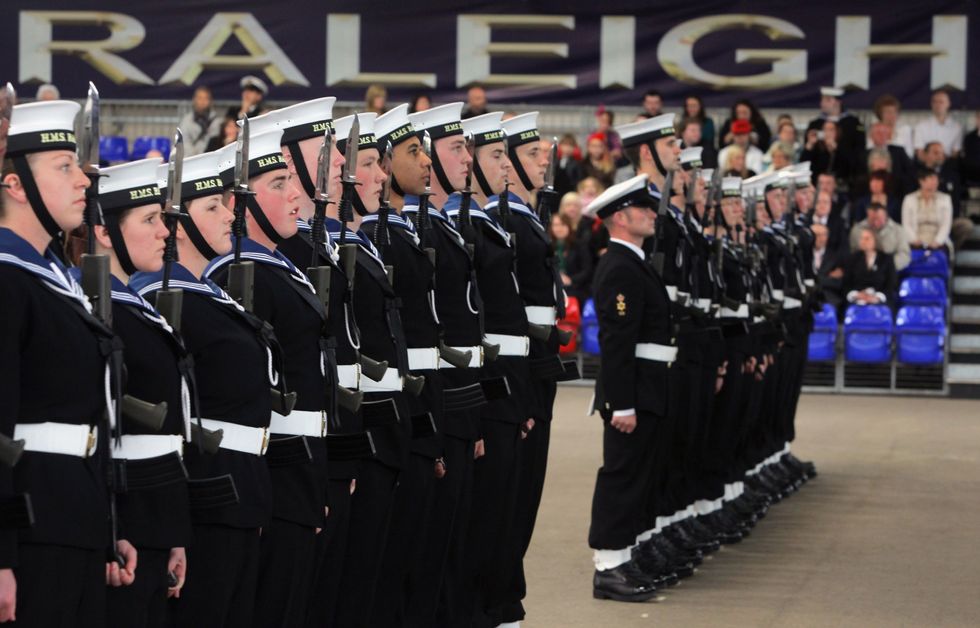Eliana Silver
Guest Reporter
The Royal Navy has updated its formal dress code to allow officers to wear "cultural dress" in its latest push to be "inclusive".
The change, announced following consultation with the service's race diversity network, expands existing rules that previously permitted only kilts and tartan dress for formal occasions.
Officers can now celebrate their heritage through cultural dress whilst maintaining standard military formality, though they must still wear the traditional mess jacket, shirt and bow tie above the waist.
The policy change was highlighted in a photo shared on LinkedIn featuring Hon Capt Durdana Ansari, wearing a white sari beneath her mess jacket.

Navy sources clarified that the photograph, which included civilians, was from an initial trial and does not fully represent the updated dress code.
The new regulations maintain strict requirements above the waist, with officers required to pair any cultural dress with the standard mess jacket, shirt and bow tie.
The update builds upon existing allowances that had previously permitted Scottish, Irish, Welsh, Cornish and Manx personnel to wear kilts and tartan dress.
Lance Cpl Jack Kanani, chairman of the Royal Navy race diversity network, praised the update as being "inclusive of other British cultures".
MORE LIKE THIS:
"The network canvassed opinions from ethnic minority service personnel to understand how widening existing policy on cultural mess dress would make them feel able to celebrate both their Royal Navy and cultural heritage," he said.
He noted that existing policy had already allowed for Celtic heritage representation through kilts and tartan dresses, and the update now extends this inclusivity to other British cultures serving within the Royal Navy.
Retired Rear Adml Philip Mathias criticised the changes, stating the Royal Navy had "exposed itself to ridicule" with the new policy.
“Apart from those who are diversity, equality [sic] and inclusion (DEI) fanatics, I suspect this image will shock many members of the public given the diminished state of the Navy,” he said.
"The whole point of uniform in a disciplined fighting service – even in a social setting – is to achieve a sense of common identity, not to accentuate differences," he said.
He argued that whilst cultural identity should be celebrated in civilian clothing, it "should not be mixed with uniform".
The former nuclear submarine commanding officer suggested the Navy's focus should instead be on "maintaining its warfighting capability in an increasingly dangerous world".
Retired Royal Navy commander Tom Sharpe offered a balanced perspective on the changes, acknowledging the inherent tension in uniform policy.

"All services, and their sub-divisions, have had variations of uniforms since uniforms began," he said, noting that while uniformity supports fighting cohesion, recruitment needs must also be considered.
He added: "I was strict on uniform at sea, I thought it was an important part of the whole business. At a mess dinner though, does it matter as much?"
A Royal Navy spokesman said: "We are proud to welcome people from a variety of backgrounds to attract and retain the best people available."
The latest change follows nearly three decades since the Navy's previous major update to mess dress regulations in 1996, when officers were first permitted to wear tartan kilts or skirts.
At that time, the Navy noted that tartan was "harmless, colourful and supported by several very senior officers".
Before the 1996 change, officers faced penalties for wearing kilts without permission, including being fined a round of port in the mess.
The current policy maintains that all cultural dress variations must conform to standard mess uniform requirements above the waist, including the traditional jacket, shirt and bow tie.
Find Out More...
The change, announced following consultation with the service's race diversity network, expands existing rules that previously permitted only kilts and tartan dress for formal occasions.
Officers can now celebrate their heritage through cultural dress whilst maintaining standard military formality, though they must still wear the traditional mess jacket, shirt and bow tie above the waist.
The policy change was highlighted in a photo shared on LinkedIn featuring Hon Capt Durdana Ansari, wearing a white sari beneath her mess jacket.

Navy sources clarified that the photograph, which included civilians, was from an initial trial and does not fully represent the updated dress code.
The new regulations maintain strict requirements above the waist, with officers required to pair any cultural dress with the standard mess jacket, shirt and bow tie.
The update builds upon existing allowances that had previously permitted Scottish, Irish, Welsh, Cornish and Manx personnel to wear kilts and tartan dress.
Lance Cpl Jack Kanani, chairman of the Royal Navy race diversity network, praised the update as being "inclusive of other British cultures".
MORE LIKE THIS:
- REVEALED: The astonishing amount woke hires cost UK taxpayers as Donald Trump axes DEI industry
- 'Treated like a snowflake!' University slaps woke trigger warnings on Shakespeare plays for 'storms' and 'depiction of magic'
- NHS advertises dozens of 'woke' jobs with salaries up to £123k - despite Labour pledging to curb diversity drives
"The network canvassed opinions from ethnic minority service personnel to understand how widening existing policy on cultural mess dress would make them feel able to celebrate both their Royal Navy and cultural heritage," he said.
He noted that existing policy had already allowed for Celtic heritage representation through kilts and tartan dresses, and the update now extends this inclusivity to other British cultures serving within the Royal Navy.
Retired Rear Adml Philip Mathias criticised the changes, stating the Royal Navy had "exposed itself to ridicule" with the new policy.
“Apart from those who are diversity, equality [sic] and inclusion (DEI) fanatics, I suspect this image will shock many members of the public given the diminished state of the Navy,” he said.
"The whole point of uniform in a disciplined fighting service – even in a social setting – is to achieve a sense of common identity, not to accentuate differences," he said.
He argued that whilst cultural identity should be celebrated in civilian clothing, it "should not be mixed with uniform".
The former nuclear submarine commanding officer suggested the Navy's focus should instead be on "maintaining its warfighting capability in an increasingly dangerous world".
Retired Royal Navy commander Tom Sharpe offered a balanced perspective on the changes, acknowledging the inherent tension in uniform policy.

"All services, and their sub-divisions, have had variations of uniforms since uniforms began," he said, noting that while uniformity supports fighting cohesion, recruitment needs must also be considered.
He added: "I was strict on uniform at sea, I thought it was an important part of the whole business. At a mess dinner though, does it matter as much?"
A Royal Navy spokesman said: "We are proud to welcome people from a variety of backgrounds to attract and retain the best people available."
The latest change follows nearly three decades since the Navy's previous major update to mess dress regulations in 1996, when officers were first permitted to wear tartan kilts or skirts.
At that time, the Navy noted that tartan was "harmless, colourful and supported by several very senior officers".
Before the 1996 change, officers faced penalties for wearing kilts without permission, including being fined a round of port in the mess.
The current policy maintains that all cultural dress variations must conform to standard mess uniform requirements above the waist, including the traditional jacket, shirt and bow tie.
Find Out More...
